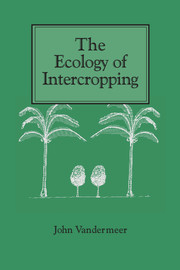Book contents
- Frontmatter
- Contents
- Preface
- 1 Introduction: intercrops and ecology
- 2 The measurement of intercrop performance
- 3 The competitive production principle
- 4 Facilitation
- 5 Mechanisms of the competitive production principle
- 6 The environments modified to produce facilitation
- 7 Special problems in intercrops involving perennials
- 8 Weeds and intercrops
- 9 Variability and intercrops
- 10 Planning intercrops – a phenomenological approach
- 11 Planning intercrops – a mechanistic approach
- 12 Critical research directions for the future
- References
- Author index
- Subject index
10 - Planning intercrops – a phenomenological approach
Published online by Cambridge University Press: 05 August 2012
- Frontmatter
- Contents
- Preface
- 1 Introduction: intercrops and ecology
- 2 The measurement of intercrop performance
- 3 The competitive production principle
- 4 Facilitation
- 5 Mechanisms of the competitive production principle
- 6 The environments modified to produce facilitation
- 7 Special problems in intercrops involving perennials
- 8 Weeds and intercrops
- 9 Variability and intercrops
- 10 Planning intercrops – a phenomenological approach
- 11 Planning intercrops – a mechanistic approach
- 12 Critical research directions for the future
- References
- Author index
- Subject index
Summary
In previous chapters a variety of theoretical approaches, mainly borrowed from the ecological literature, have been presented. For the most part these formulations have been intended as a framework within which intercrops can be viewed, hoping that some qualitative insights of intercrop dynamics might be revealed in the process. In the present chapter and the one that follows we turn to the practical question of how to use such a theoretical framework in the context of intercrop design.
This problem can be approached in two philosophically distinct ways, as has most of the theory already presented. First is what I call the phenomenological approach, common in the ecological literature, in which the problem is formulated as the quantitative response of one species to varying quantities of a second species. Our concern is simply with the quantitative effect of one species on another, specifically ignoring what might be the underlying causes of that effect. Competition and facilitation are thought of as phenomena worthy of study in their own right, irrespective of the underlying mechanisms that produce the observable competitive or facilitative effects.
The second approach is the mechanistic approach, in which competition and/or facilitation are assumed, but the interest is in the study of the mechanisms that cause them. Thus, competition may be for nitrogen or facilitation may be a consequence of protection from herbivores. The mechanism of overyielding might be the partitioning of the nitrogen environment or the mechanism of facilitation might be disrupting oviposition behavior of a key herbivore.
- Type
- Chapter
- Information
- The Ecology of Intercropping , pp. 162 - 175Publisher: Cambridge University PressPrint publication year: 1989



